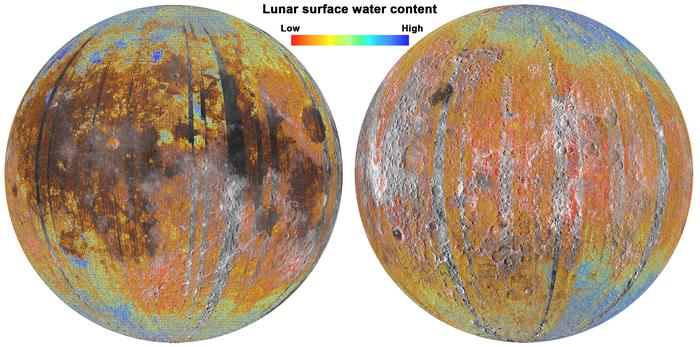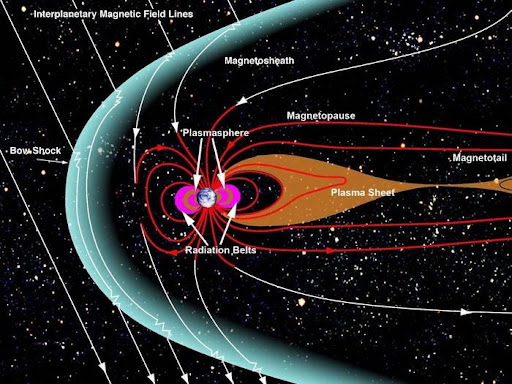High-energy electrons in Earth's magnetic tail may form water on the moon
The discovery could help scientists better understand where water is on the lunar surface, knowledge that could be used in future crewed moon missions.

High-energy electrons located in a tail of plasma around the Earth are weathering the moon and, more excitingly, seem to have given rise to water across the lunar surface.
The new findings, reached by a team of researchers led by Shuai Li, a scientist at the University of Hawaii at Mānoa School of Ocean and Earth Science and Technology, could also explain how water gathers in pockets across the moon that never see sunlight called permanently shaded regions (PSRs).
Knowledge of water distribution and concentration across the moon isn’t only essential for understanding how Earth's natural satellite has evolved, but it's also important for planning future prolonged crewed missions to the moon. Water could be harvested by those space explorers not just as sustenance, but also to generate fuel that can be used for staging missions from the lunar surface. These missions could use the moon as a stepping stone for exploration deeper into the solar system, including on Mars.
Li and team’s theory connects water on the moon to the magnetic bubble that surrounds the Earth called the magnetosphere. The magnetosphere shields our planet from high-energy charged particles delivered from the sun in the solar wind.
Related: A big telescope on the moon could peer deeper into the universe than James Webb
As the solar wind smacks into the magnetosphere, it deforms this magnetic shield, creating a long magnetic tail on the side of the Earth facing away from the sun, aka the nightside of the planet. This tail is aptly called the magnetotail. High-energy electrons and ions from the solar wind (and from Earth itself) form a plasma sheet within the magnetotail.
So, as the moon orbits Earth, it passes through the magnetotail. As a result, just as the magnetosphere shields the Earth, the magnetotail shields the moon from charged particles while allowing light to still reach the lunar surface.
Get the Space.com Newsletter
Breaking space news, the latest updates on rocket launches, skywatching events and more!
"This provides a natural laboratory for studying the formation processes of lunar surface water," Li said in a statement. "When the moon is outside of the magnetotail, the lunar surface is bombarded with solar wind. Inside the magnetotail, there are almost no solar wind protons, and water formation was expected to drop to nearly zero."
He and the team used data collected between 2008 and 2009 by the Moon Mineralogy Mapper (MMM) instrument onboard the Chandrayaan 1 spacecraft to assess how water formation changes as the moon passes through the magnetotail.
"To my surprise, the remote sensing observations showed that the water formation in Earth’s magnetotail is almost identical to the time when the moon was outside of the Earth’s magnetotail," Li explained. "This indicates that, in the magnetotail, there may be additional formation processes or new sources of water not directly associated with the implantation of solar wind protons."
In particular, Li found that radiation caused by high-energy electrons in the magnetotail exhibits similar effects to those caused by ions in the solar wind.

Li had initially started thinking about the interaction between the magnetotail and the moon by considering weathering processes on the lunar surface that occur as the moon passes through the magnetic tail of Earth. This revealed that oxygen in the magnetotail rusts iron in the polar regions of the moon.
"Altogether, this finding and my previous findings of rusty lunar poles indicate that Mother Earth is strongly tied with its Moon in many unrecognized aspects," Li added.
The team intends to follow up this discovery by investigating the plasma environment around the moon and water content at the lunar poles during different points in the moon’s passage through the magnetotail.
This work will be conducted as part of the Artemis program, which, as soon as 2026, will also send the Artemis III mission to the moon. That endeavor is meant to return humanity to the moon for the first time in 50 years and send the first woman and the first person of color to the lunar surface.
The team’s research was published Sept. 14 in the journal Nature Astronomy.
Join our Space Forums to keep talking space on the latest missions, night sky and more! And if you have a news tip, correction or comment, let us know at: community@space.com.

Robert Lea is a science journalist in the U.K. whose articles have been published in Physics World, New Scientist, Astronomy Magazine, All About Space, Newsweek and ZME Science. He also writes about science communication for Elsevier and the European Journal of Physics. Rob holds a bachelor of science degree in physics and astronomy from the U.K.’s Open University. Follow him on Twitter @sciencef1rst.









